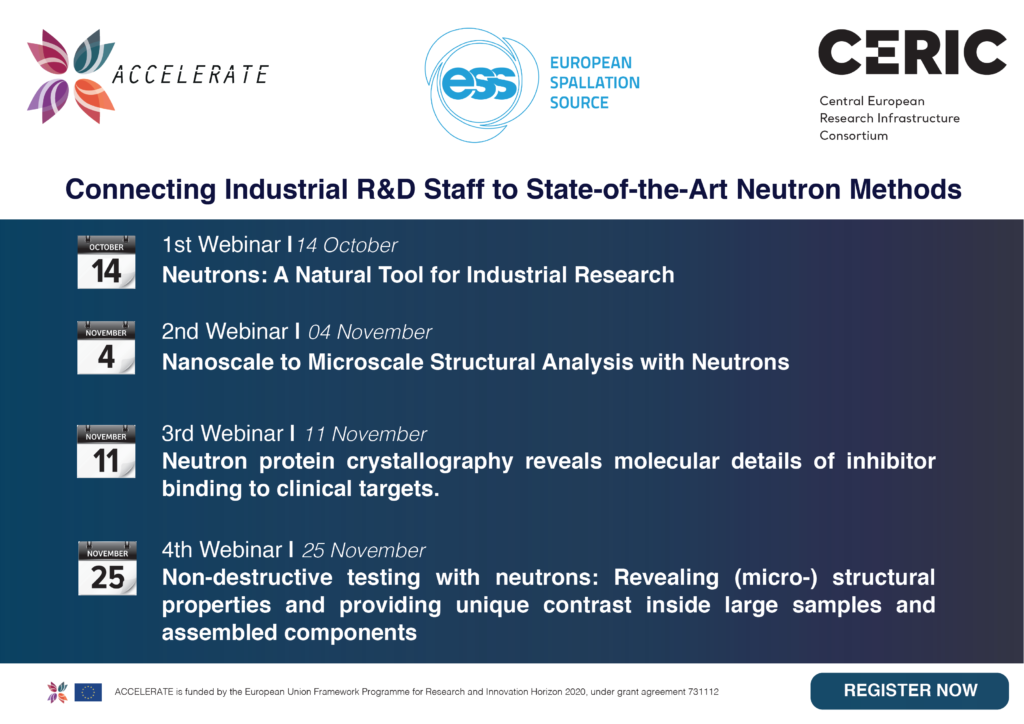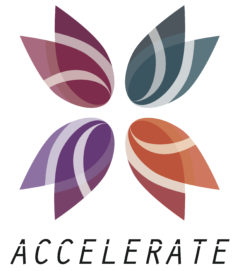
In the frame of the H2020 project ACCELERATE, a series of webinars focused on state-of-the-art neutron methods will be held in October and November 2020. Each talk will be facilitated by an expert in the field from the European Spallation Source.
This series of webinars aims to bring together researchers from industry as well as R&D staff from both academia and industry to exchange knowledge and expertise. Each talk will be focused on a specific field of application which would be of high interest for researchers working in the food, pharmaceutical, and energy sectors.
1st webinar: Neutrons: A Natural Tool for Industrial Research
Date and time: 14 October 2020 at 15:00 (CET)
Speaker: Dr. Andrew Jackson, Acting Head Neutron Instruments Division, Group Leader Instrument Scientists (European Spallation Source)
Overview
Neutron beams are highly penetrating, non-destructive, and sensitive to light elements and magnetic structures. As such neutron scattering, imaging and spectroscopy form a family of methods that provide unique insight into structure, dynamics and kinetics from the atomic to macroscopic scale.
Whilst neutrons have played a key role in many fields of academic research, the special characteristics of neutrons, and the maturity of many of the techniques, lend themselves to application in industrial R&D. Neutron methods have been successfully employed in areas ranging from formulations and personal care products, through to understanding strains in aircraft wings.
This talk will give an overview of why we choose to study materials with neutrons, how we generate neutron beams, and what types of measurements are possible. Examples of applications from a broad spectrum of industrial research will be presented, with a view to both giving an opportunity for discussion and as an introduction to the rest of the seminars in the series.
Read here the speaker’s biography.
2nd webinar: Nanoscale to Microscale Structural Analysis with Neutrons
Date and time: 4 November 2020 at 15:00 (CET)
Speaker: Dr. Judith Houston, Instrument Scientist for LoKI (European Spallation Source)
Overview
The interactions and assembly behaviour of a product’s components in the nano-range, such as the colloidal building blocks in milk, or the polymer chains in plastic thin film coverings, determine not only the structure of the material at the nanoscale, but also directly influence that materials’ structure, rheology and functional properties at the macroscopic scale. Therefore, when designing new products, such as food, drug formulations or packaging, it is increasingly important to understand the relationship between the structural and functional properties of that material’s constituent components.
Small-angle neutron scattering (SANS) is an ideal technique to help us unravel complex soft matter structures on the 1-500 nm scale. The specific properties of neutrons, such as their capability to distinguish light elements and their isotopes (e.g. 1H (hydrogen) and 2H (deuterium)), or their negligible absorption, make them particularly useful in the field of soft matter. Firstly, by selectively deuterating components of a complex material, we can create contrast in an otherwise homogenous system without altering its physico-chemical properties. Such components can then be rendered effectively invisible in the measured scattering data when combined with judicious selection of the solvent. Therefore, this method of contrast-variation enables full structural characterisation of not only the global structure, but also its constituent components and their interaction, which cannot be obtained by light or x-ray scattering. In addition, the comparatively weak interaction between neutrons and matter, enables them to penetrate most materials. As a result, we can design relatively complex sample environments for in situstudies with neutrons. This has powerful implications for studying the evolution of nanoscale structures in industrial processes, without the need for overly simplified model set-ups. Finally, their non-invasive nature makes neutron perfect to study bio-relevant material without radiation damage.
This talk will include numerous examples from the literature aiming to highlight the versatility of neutron scattering for industrial applications, from understanding the structure of food or packaging to demonstrating the flexibility of neutrons to study processing techniques.
Read here the speaker’s biography.
► Register now.
3rd webinar: Neutron protein crystallography reveals molecular details of inhibitor binding to clinical targets.
Date and time: 11 November 2020 at 15:00 (CET)
Speaker: Dr. Zöe Fisher, Group Leader Deuteration and Macromolecular Crystallisation (European Spallation Source)
Overview:
Ligand binding to proteins are mediated through numerous interactions. These can include direct hydrogen bonds, water-mediated interactions, electrostatics, metal coordination, energetic changes through water displacement, aromatic ring stacking, and hydrophobic interactions.
Using X-ray crystallography as a tool for the study of protein: ligand complexes is a powerful and high throughput approach, but cannot elucidate many of the atomic details of the types of interactions involved. Neutrons can fill this knowledge gap as they have unique properties that enable us to determine the location of light atoms [1H (Hydrogen), and its isotope 2H (Deuterium)]. By extension then it is possible to observe hydrogen bonds and infer electrostatics based on presence or absence of a hydrogen atoms on the protein but also the ligand. This can inform the researcher on the charged state of a ligand, the involvement of water molecules, and the charged state of amino acid side chains involved in binding.
Combining the unique information from neutron crystallography with high resolution X-ray crystallography, it is then possible to obtain a complete and accurate view of the interactions that drive ligand binding. This talk will include examples from the literature on where this strategy was employed to investigate novel compounds binding to a cancer metastasis marker, and clinically used protease inhibitors to HIV protease.
Read here the speaker’s biography.
► Register now.
4thwebinar: Non-destructive testing with neutrons: Revealing (micro-) structural properties and providing unique contrast inside large samples and assembled components
Date and time: 25th November 2020 at 15:00 (CET)
Speaker: Dr. Robin Woracek, Instrument Class Coordinator for Imaging and Engineering, Instrument Scientist for Test Beamlines and Engineering (European Spallation Source)
Overview
While neutron based material characterization tools may seem exotic, they have much in common with more widely available microscopy techniques or x-ray based diffraction and computed tomography methods. Due to the high penetration power of neutrons into most materials and the unique contrast they provide, they complement the more standard tools and moreover, are invaluable for in situ and in operando investigations.
Large-scale neutron infrastructure methodology has played key roles in the innovation of engineering systems and provided insights about materials and processes that enable developments of novel and improved products. Thanks to the high contrast for elements like Hydrogen and Lithium, neutron imaging and diffraction has been used to optimize the fuel cell technology that will power our cars tomorrow, to gain insight into the operation of batteries, as well as to reveal corrosion in airplane components. The high penetration power allows probing deep inside of metallic alloys to study phase transitions, determining internal residual stresses or crystallographic texture, hence significantly expanding what can be done using electrons or x-rays.
This presentation will summarize the most important neutron characterization tools for the study of engineering materials and components, and beyond that will aim to spark ideas on how neutrons can help to solve open questions and problems that you are currently facing in your industry.
Read here the speaker’s biography.
► Register now.
